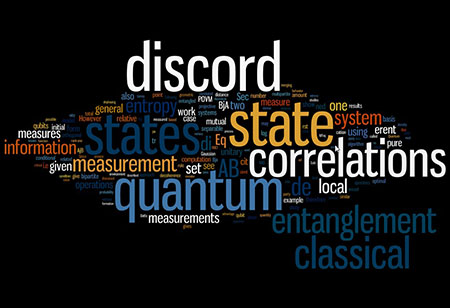Highlights
Everything you ever wanted to know about measuring quantumness
Recently there has been a rush of new theoretical approaches to describing the quantumness of systems, with different measures promising insight in different situations. A review paper by CQTians and collaborators collates the ideas. The word cloud was generated at www.wordle.net from the article text.
Even before the article "The classical-quantum boundary for correlations: Discord and related measures" was published in Reviews of Modern Physics on 26 November, it had been cited nearly 100 times. The paper by CQT researchers Kavan Modi, Hugo Cable, Tomasz Paterek and Vlatko Vedral, with collaborator Aharon Brodutch had been on the physics preprint server arXiv for less than a year.
As the rapid citations show — on average recent papers in Reviews of Modern Physics attract some 44 citations per year, going by the journal's 2011 impact factor — the article covers a lively research topic.
It used to be the case that researchers saw 'entanglement' — two particles being entwined in a single quantum state such that the particles' behaviour is perfectly coordinated — as being the most important kind of quantum correlation. Entanglement was thought to be essential to gaining quantum speed-ups in computing, for example.
However, in the past decade, researchers have realised that weaker forms of correlation may have applications too. That has stirred interest in ways of measuring such quantumness: mathematical approaches to teasing out the quantum properties mixed up with classical properties.
"The field grew very quickly and this probably made things confusing, because people were coming up with new definitions all the time," says Hugo. For example, two measures of quantumness considered in the review, discord and deficit, come in many different variants. The review collates ideas about how the variants are related and in what situations they are relevant.
Research suggests that some of the newer measures of correlations are relevant to understanding quantum-information-processing tasks, quantum thermodynamics, open-system dynamics, and many-body physics. CQT researchers have taken a strong role in exploring these ideas, from involvement in very recent experiments, to organising and hosting a workshop on quantum discord.
"This field is still developing at a very fast rate and it was difficult deciding what to include and how long to wait for any new developments. In the end I think the review came out well," says Vlatko.
The review article is more than 50 pages long and gives over 300 references. "Remarkably we've only had fewer than 10 emails saying that we are missed a reference," says Kavan, who coordinated the project.
Each author was responsible for writing two sections, and once the bulk was done, the group met in Singapore. "In September 2011, we sat in the CQT conference room and read the article together line by line for three nights in a row till 3am. We argued through every issue and left nothing out from discussions. One important outcome of this process is that we have connected seemingly unconnected parts of the article in a coherent way," says Kavan.
Kavan is now a Visiting Research Fellow with an appointment at the University of Oxford. Vlatko, a CQT Principal Investigator and Professor in NUS, is also a Professor at the University of Oxford. Hugo is a CQT Research Fellow. Tomasz, also a CQT Research Fellow, has recently taken an appointment with Singapore's Nanyang Technological University. Aharon is affiliated with Macquarie University, Sydney, Australia and the University of Waterloo, Ontario, Canada.
The reference for the review is "The classical-quantum boundary for correlations: Discord and related measures" Rev. Mod. Phys. 84, 1655 (2012); arXiv:1112.6238.
Learn more
- Chau Thanh Tri
- Adrian Nugraha Utama
- A decoupling approach to classical data transmission over quantum channels (2014). IEEE Trans. Inf. 60 1562-1572
- A CONSTRUCTIVE QUANTUM LOVASZ LOCAL LEMMA FOR COMMUTING PROJECTORS (2015). Quantum Information and Computation 15
- (4,1)-Quantum random access coding does not exist-one qubit is not enough to recover one of four bits (2006). New J. Phys. 8 129
Related Stories
 | 2012 Nobel Prize in Physics to pioneers of quantum technologies October 09 2012 |
 | 'Evocative' data visualisation takes top spot in Quantum Shorts film contest April 27 2015 |







